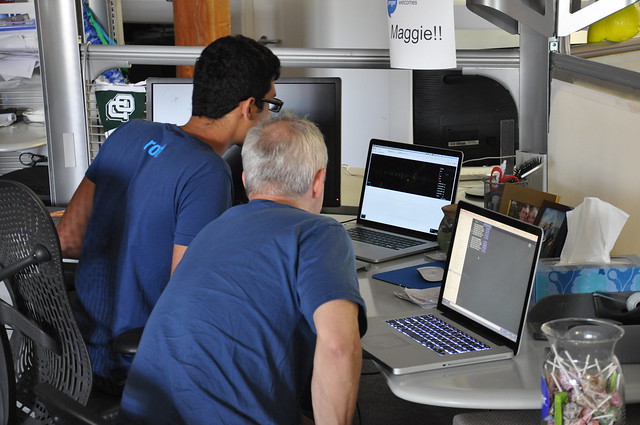| blog
2014 Spring Hackathon Outcome
We had a great hackathon event this past weekend. This was our third hackathon, and it resulted in the most hackers, the most hacks, and the most productive environment yet. Even if you could not attend, I hope the videos and photographs below help you to understand NuPIC better by example.

Below, you’ll find the following:
- Sessions: Videos of informational talks given by Numenta engineers
- Demos: Hackathon demos presented at the end
- Photos: Taken at the hackathon (on Flickr)
Big thanks to Pinger, who graciously donated their space to us for the event!
The hackathon brought in attendees from all over the world. We started at 10AM on Saturday with a kickoff presentation, helped people get NuPIC installed, then held several informational sessions throughout the day. Breakfast, lunch, and dinner were served.
Testimonials
Everyone seemed to have a great time, and most people stuck around through the event (sans some sleep time!) to see the demos at the end.
-
"Another outstanding event! Thanks Numenta!"
-
"Learned a ton, great people, great numenta staff, matt++ :)"
-
"It was great to meet the community and to exchange ideas"
-
"Comparing with the Fall 2013: 1. More people with serious interest in the NuPIC/Theory, 2. More hacks worked on and presented, 3. Previous "hacks" extended (CEPT!), 4. Theory has made progress towards deeper understanding of brain. Great to see the people from Numenta, the previous event, and new people with practical interest !"
-
"Really great, even better than in the Fall. Thanks to everyone who worked really hard to make the hackathon go so smoothly, and to all who took part. It was a real pleasure to meet so many smart people, all interested in furthering Machine Intelligence."
Kickoff

Matt Taylor & Jeff Hawkins
Where hackers are welcomed to the hackathon, protocol is reviewed, and ideas are brainstormed.
Sessions
Just like last hackathon, we had several presentations from NuPIC engineers for hackathon participants to attend, if wanted. You can also view them all in this playlist.

Beginner's Guide to NuPIC
Scott Purdy
A detailed introduction to the components of NuPIC. Includes encoders, the spatial pooler, and swarming. Contains live code running in an iPython Notebook, which is included as a reference.

Anomaly Detection in CLA
Subutai Ahmad
Subutai talks about how anomaly detection works in NuPIC, as well as how Grok processes NuPIC's anomaly scores to provide better "anomaly likelihood" values.

Temporal Pooling Fireside Chat with Jeff Hawkins
Jeff Hawkins
Jeff sits down for an up-close-and-personal discussion about his ideas about temporal pooling. Attendees ask him questions as he describes his theories on the whiteboard.

CLA as Implemented in NuPIC
Chetan Surpur
Numenta engineer Chetan Surpur goes into great detail about the implementations of the spatial and temporal poolers in NuPIC.

The State of NuPIC
Matt Taylor
Matt talks about how far we've come as an open source project in the past year, the current state of NuPIC, and plans for the future.
Demos
We had a lot of demos at this hackathon! In addition to the full playlist of all our hackathon demonstrations, I’ve broken out each hack below with further information about the participants and source code (if available).

NuPIC Critic
Matt Taylor
An attempt to get NuPIC to report anomalies when the characteristics of audio input changes.

NuPUCK
Steve Levis
Steve incorporated NuPIC into the TuxPuck program to help control a player against an AI adversary.

SatPIC
Shashwat Kandadai and Andrew Morrison
An attempt to configure NuPIC to predict the orbit of a satellite.

Cerebro 2
Chetan Surpur and Jeff Fohl
A platform for showing visualizations of a CLA model, which includes a 3D display of both spatial pooler and sequence memory components.

Predictive Web Browser
Julie Pitt
Julie hooks up NuPIC to analyze web browser history to predict which website domain you'll be navigating to next.

Back Seat Driver
Marcus Lewis
Explores the space of how NuPIC might help analyze events streams in client-based software. In this case he analyzes events coming from Internet Explorer.

SP+JS+MNIST
Ian Danforth
Ian shows off some visualizations in JavaScript of the spatial pooler and applies it to the MNIST handwriting recognition data set.

Coachella
Paulin Andurand, Antoine Chkaiban
The goal was to mix different types of data about the same concept (words) and feed them into the CLA.

Say What?
Matt Roos, Will Gray Roncal, Dean Kleissas
Analyzing speech data (TIMIT), trying different experiments to try to use NuPIC to predict male vs female speakers. Also explored different representations of the audio signal to see what works best with NuPIC.

Famous
Francisco Webber, Soeren, and Erik from CEPT.
Trying to teach NuPIC to understand complex word associations with CEPT word SDRs.

Single-Entry Multifactor Authentication
Wade Hought
Wade uses NuPIC to try help with authentication not only by the password entered, but also the characteristics of the keystrokes entered.

Moksha
Sergey and Mohamed
An interesting hack using NuPIC to identify anomalous behavior using Facebook check-ins.
This was our most successful hackathon yet. Thanks to everyone who participating in the event, helped out with the planning and execution, and even for those of you watching the videos now. I hope you’ll considering attending our next hackathon!
Matt Taylor
Open Source Community Flag-Bearer
Numenta, Inc.
By the way! You can see all the videos and photos taken at this hackathon on our YouTube channel and Flickr page.
Back to Blog





